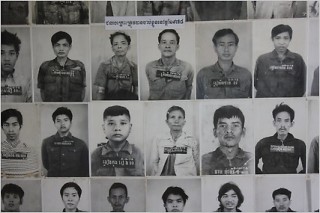By Brian Turner New York Times / PHNOM PENH — It’s mid-afternoon. From my hotel room at the Bright Lotus Lodge — only a block from where the Tonle Sap converges with the Mekong River — I can hear the keyboard strains of The Doors’ “Light My Fire” drifting out from one of the bars on the riverfront.
I’m lying in bed with a blanket pulled up over my shoulders, arms and legs shivering with fever, my forehead

hot, my internal thermostat all screwed up. I don’t have a cough or a sore throat or diarrhea, thankfully — it’s a traveler’s cold, I think. The symptoms at the moment include fever, muscle tremors, fatigue, lack of appetite, nausea. What I would’ve called a really bad case of “the crud” back when I was in the military.
Outside, the riverside boulevard, Sisowath Quay, temporarily closes down until the king and his entourage drive by from the nearby Royal Palace. Things return to normal soon afterward. The tour buses unload their passengers near the palace entrance. Most of the foreigners try to ignore the man in the wheelchair, the man without legs who told me he lost them to a mine in Battambang province back in 1995. He wears a cardboard sign on his chest that explains he’s not begging, just trying to earn a living selling books (some of which I highly recommend, like “The Gate” by Francois Bizot and Jon Swain’s “River of Time.”)
Somewhere nearby a young woman in rags pulls a broken-down wood and metal vegetable cart with a man — or the remnants of a man — strapped to the wooden top. The man is moaning in a high tenor — an incomprehensible and yet fully recognizable pain, both of his legs permanently wrecked, bent out of plane by polio, perhaps, or some other disfigurement of birth or bad fortune, though I don’t really know.
There are a long line of people like this, street by street, trying to scratch out a living.
All photos by Brian Turner Photographs of prisoners at Cambodia’s S-21 on display at the Tuol Sleng Genocide Museum.
Earlier in the day, I went to S-21 at Tuol Sleng, the former high school that was turned into a prison and death camp by the Khmer Rouge in the 1970’s. Of the some 17,000 prisoners that passed through the S-21, only a handful survived. It is now part of the Tuol Sleng Genocide Museum. Raksmey, one of the drivers who sleeps in his motoremorque, drove me out there early in the morning.
Read more at Home Fires: New York Times
Brian Turner served seven years in the Army, most recently in 2004 as an infantry team leader in Mosul with the Third Stryker Brigade Combat Team, Second Infantry Division. His 2005 book of poems, “Here, Bullet,” has won several awards. He is the recipient of the 2009-2010 Amy Lowell Traveling Scholarship and teaches at Sierra Nevada College.
ATTENTION READERS
We See The World From All Sides and Want YOU To Be Fully InformedIn fact, intentional disinformation is a disgraceful scourge in media today. So to assuage any possible errant incorrect information posted herein, we strongly encourage you to seek corroboration from other non-VT sources before forming an educated opinion.
About VT - Policies & Disclosures - Comment Policy



